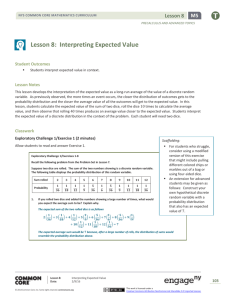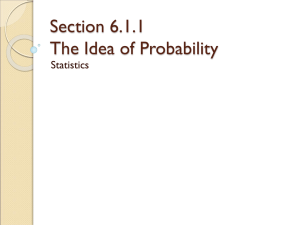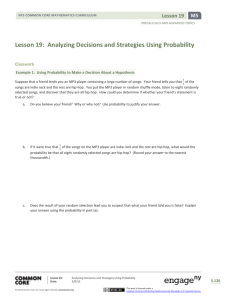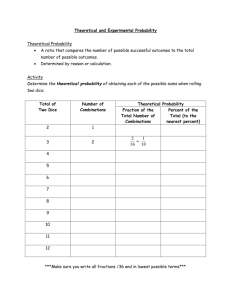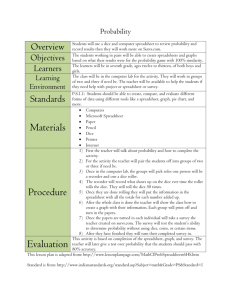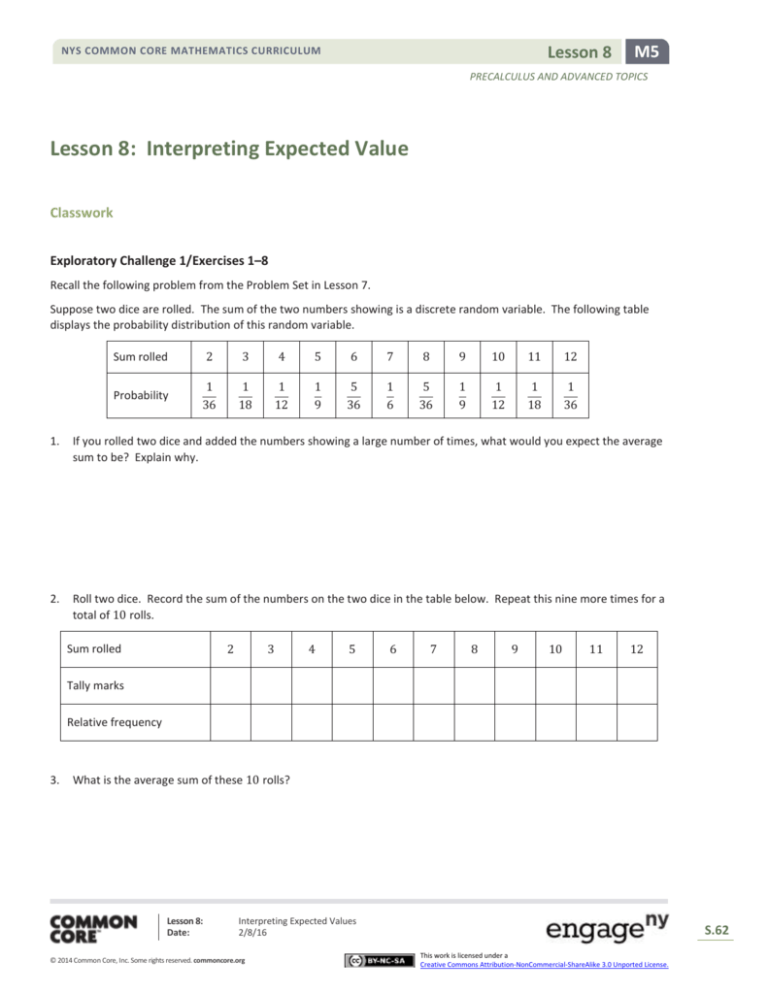
Lesson 8
NYS COMMON CORE MATHEMATICS CURRICULUM
M5
PRECALCULUS AND ADVANCED TOPICS
Lesson 8: Interpreting Expected Value
Classwork
Exploratory Challenge 1/Exercises 1–8
Recall the following problem from the Problem Set in Lesson 7.
Suppose two dice are rolled. The sum of the two numbers showing is a discrete random variable. The following table
displays the probability distribution of this random variable.
Sum rolled
2
3
4
5
6
7
8
9
10
11
12
Probability
1
36
1
18
1
12
1
9
5
36
1
6
5
36
1
9
1
12
1
18
1
36
1.
If you rolled two dice and added the numbers showing a large number of times, what would you expect the average
sum to be? Explain why.
2.
Roll two dice. Record the sum of the numbers on the two dice in the table below. Repeat this nine more times for a
total of 10 rolls.
2
Sum rolled
3
4
5
6
7
8
9
10
11
12
Tally marks
Relative frequency
3.
What is the average sum of these 10 rolls?
Lesson 8:
Date:
Interpreting Expected Values
2/8/16
© 2014 Common Core, Inc. Some rights reserved. commoncore.org
S.62
This work is licensed under a
Creative Commons Attribution-NonCommercial-ShareAlike 3.0 Unported License.
Lesson 8
NYS COMMON CORE MATHEMATICS CURRICULUM
M5
PRECALCULUS AND ADVANCED TOPICS
4.
How does this average compare to the expected value in Exercise 1? Are you surprised? Why or why not?
5.
Roll the two dice 10 more times, recording the sums. Combine the sums of these 10 rolls with the sums of the
previous 10 rolls for a total of 20 sums.
2
Sum rolled
3
4
5
6
7
8
9
10
11
12
Tally marks
Relative frequency
6.
What is the average sum for these 20 rolls?
7.
How does the average sum for these 20 rolls compare to the expected value in Exercise 1?
8.
Combine the sums of your 20 rolls with those of your partner. Find the average of the sum for these 40 rolls.
2
Sum rolled
3
4
5
6
7
8
9
10
11
12
Frequency
Relative frequency
Lesson 8:
Date:
Interpreting Expected Values
2/8/16
© 2014 Common Core, Inc. Some rights reserved. commoncore.org
S.63
This work is licensed under a
Creative Commons Attribution-NonCommercial-ShareAlike 3.0 Unported License.
Lesson 8
NYS COMMON CORE MATHEMATICS CURRICULUM
M5
PRECALCULUS AND ADVANCED TOPICS
Exploratory Challenge 2/Exercises 9–12
9.
Combine the sums of your 40 rolls above with those of another pair for a total of 80 rolls. Find the average value of
the sum for these 80 rolls.
10. Combine the sums of your 80 rolls with those of the rest of the class. Find the average sum for all the rolls.
2
Sum rolled
3
4
5
6
7
8
9
10
11
12
Frequency
Relative frequency
11. Think about your answer to Exercise 1. What do you notice about the averages you have calculated as the number
of rolls increase? Explain why this happens.
Lesson 8:
Date:
Interpreting Expected Values
2/8/16
© 2014 Common Core, Inc. Some rights reserved. commoncore.org
S.64
This work is licensed under a
Creative Commons Attribution-NonCommercial-ShareAlike 3.0 Unported License.
Lesson 8
NYS COMMON CORE MATHEMATICS CURRICULUM
M5
PRECALCULUS AND ADVANCED TOPICS
The expected value of a discrete random variable is the long-run mean value of the discrete random variable. Refer back
to Exercise 1 where two dice were rolled and the sum of the two dice was recorded. The interpretation of the expected
value of a sum of 7 would be:
When two dice are rolled over and over for a long time, the mean sum of the two dice is 7.
Notice that the interpretation includes the context of the problem, which is the random variable sum of two dice, and
also includes the concept of long-run average.
12. Suppose a cancer charity in a large city wanted to obtain donations to send children with cancer to a circus
appearing in the city. Volunteers were asked to call residents from the city’s telephone book and to request a
donation. Volunteers would try each phone number twice (at different times of day). If there was no answer, then
a donation of $0 was recorded. Residents who declined to donate were also recorded as $0. The table below
displays the results of the donation drive.
Donation
Probability
$0
$10
$20
$50
$100
0.11
0.35
0.25
0.20
0.09
Find the expected value for the amount donated, and write an interpretation of the expected value in context.
Lesson 8:
Date:
Interpreting Expected Values
2/8/16
© 2014 Common Core, Inc. Some rights reserved. commoncore.org
S.65
This work is licensed under a
Creative Commons Attribution-NonCommercial-ShareAlike 3.0 Unported License.
Lesson 8
NYS COMMON CORE MATHEMATICS CURRICULUM
M5
PRECALCULUS AND ADVANCED TOPICS
Lesson Summary
The expected value of a discrete random variable is interpreted as the long-run mean of that random variable.
The interpretation of the expected value should include the context related to the discrete random variable.
Problem Set
1.
Suppose that a discrete random variable is the number of broken eggs in a randomly selected carton of one dozen
eggs. The expected value for the number of broken eggs is 0.48 eggs. Which of the following statements is a
correct interpretation of this expected value? Explain why the others are wrong.
a.
The probability that an egg will break in one dozen cartons is 0.48, on average.
b.
When a large number of one dozen cartons of eggs are examined, the average number of broken eggs in a one
dozen carton is 0.48 eggs.
c.
The mean number of broken eggs in one dozen cartons is 0.48 eggs.
2.
Due to state funding, attendance is mandatory for students registered at a large community college. Students
cannot miss more than eight days of class before being withdrawn from a course. The number of days a student is
absent is a discrete random variable. The expected value of this random variable for students at this college is 3.5
days. Write an interpretation of this expected value.
3.
The students at a large high school were asked to respond anonymously to the question:
How many speeding tickets have you received?
The table below displays the distribution of the number of speeding tickets received by students at this high school.
Number of tickets
Probability
0
1
2
3
4
5
0.55
0.28
0.09
0.04
0.03
0.01
Compute the expected number of speeding tickets received. Interpret this mean in context.
4.
Employees at a large company were asked to respond to the question:
How many times do you bring your lunch to work each week?
The table below displays the distribution of the number of times lunch was brought to work each week by
employees at this company.
Number of times lunch brought to work each week
Probability
0
1
2
3
4
5
0.30
0.12
0.12
0.10
0.06
0.30
Compute the expected number of times lunch was brought to work each week. Interpret this mean in context.
Lesson 8:
Date:
Interpreting Expected Values
2/8/16
© 2014 Common Core, Inc. Some rights reserved. commoncore.org
S.66
This work is licensed under a
Creative Commons Attribution-NonCommercial-ShareAlike 3.0 Unported License.
Lesson 8
NYS COMMON CORE MATHEMATICS CURRICULUM
M5
PRECALCULUS AND ADVANCED TOPICS
5.
Graduates from a large high school were asked the following:
How many total AP courses did you take from Grade 9 through Grade 12?
The table below displays the distribution of the total number of AP courses taken by graduates while attending this
high school.
Number of AP courses
Probability
0
1
2
3
4
5
6
7
8
0.575
0.06
0.09
0.12
0.04
0.05
0.035
0.025
0.005
Compute the expected number of total AP courses taken per graduate. Interpret this mean in context.
6.
At an inspection center in a large city, the tires on the vehicles are checked for damage. The number of damaged
tires is a discrete random variable. Create two different distributions for this random variable that have the same
expected number of damaged tires. What is the expected number of damaged tires for the two distributions?
Interpret the expected value.
Distribution 1:
Number of damaged tires
0
1
2
3
4
0
1
2
3
4
Probability
Distribution 2:
Number of damaged tires
Probability
Lesson 8:
Date:
Interpreting Expected Values
2/8/16
© 2014 Common Core, Inc. Some rights reserved. commoncore.org
S.67
This work is licensed under a
Creative Commons Attribution-NonCommercial-ShareAlike 3.0 Unported License.


